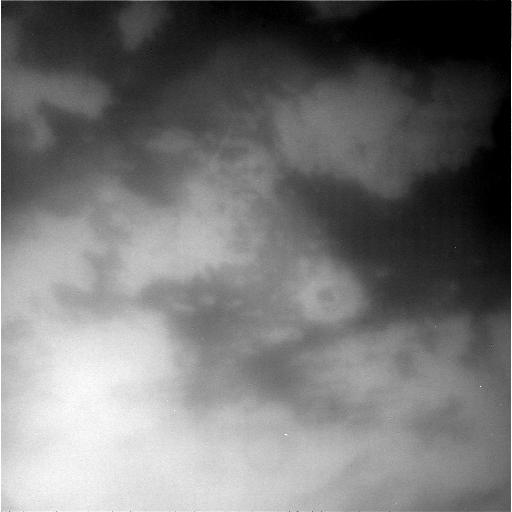February 23, 2023: A New Study Reveals That The Liquid Motion In The Presumed Subsurface Ocean Of Titan Is Influenced By The Deformation Of The Ice Shell
A new research work entitled "A numerical study of the liquid motion in Titan's subsurface ocean", published in Icarus in the volume 388 of December 2022 and proposed by a team involving David Vincent reveals the influence of the tidal forces and of the deformation of the external crust upon the dynamics of the presumed subsurface ocean likely dominated by liquid water on Titan. The largest moon of the Gas Giant Saturn is part of those worlds of the Solar System that may contain a subsurface ocean rich in liquid water. The small and bright moon Enceladus unveils geysers or eruptions revealing water ice and organics in its south polar region suggesting the presence of a subsurface ocean beneath the external crust dominated by water ice. The other major moons of Saturn tend to contain significant amounts of water ice. That's the case for Tethys, Dione or Rhea in particular. Those moons must contain a liquid layer beneath the external crust. That's also the case for other moons or worlds in the Solar System. Europa and Ganymede, two major moons of Jupiter, may contain a subsurface ocean dominated by liquid water. Triton or Charon, for instance, may also contain a subsurface ocean.
The dynamics of the ocean on Earth is influenced by the atmosphere, by tectonics, by volcanism, by solar radiations or by tidal phenomena related to the Moon in particular. On worlds where the ocean is found beneath the external crust, the logic is different. Tidal forces will tend to deform the external crust and the deformation will tend to influence the dynamics of the internal ocean. Researchers must resort to simulations or models in order to anticipate the potential dynamics of the internal ocean. The currents will be influenced by various phenomena such as the tidal forcing, the deformation of the external crust dominated by water ice and the temperature gradient related to the surface and bottom heat fluxes. Planetologists can simulate the flow engendered by the tidal forces and by the deformation of the external icy crust on the basis of a 2D depth-averaged model. The temperature gradient related to the surface and bottom heat fluxes produces horizontal and vertical density variations whose effects can only be evaluated by a 3D baroclinic model. Does the core radiate energy ? How is the energy from the Sun diffused toward the presumed internal ocean ? Many factors or parameters must be considered.
The group of David Vincent and Robert H. Tyler analyzed the tides of the subsurface ocean of the Opaque Moon as well as the influence of the external ice shell on the movement of the liquid on the basis of the Second-generation Louvain-la-Neuve Ice-ocean Model known as SLIM. The influence or the action of the external ice crust is simulated by a surface friction term and surface pressure terms. Surface pressure terms appear to be a function of the difference between the ocean elevation and the vertical movement of the crust and the time derivative of this difference. A parallel can be drawn between the tidal motion of Titan and the tidal motion of Europa due to the appreciable obliquity of the Orange Moon (0.306 degrees). The tidal configuration of Europa had been described by Robert H. Tyler in 2008. The surface elevation is characterized by two bulges turning around the giant moon and the associated depth-averaged velocity field is characterized by two gyres or two major whirlpools separated by a region of high speed flow. The middle of those gyres or major circular patterns has a sinusoidal movement centered at the level of the equator.
The icy crust tends to damp the dynamics of the surface implying a slower motion of the flow. That configuration does not significantly change the spatial patterns of those circular structures. The group of researchers performed a sensitivity analysis on the basis of hypotheses regarding the depth of the internal ocean and regarding the mechanical characteristics of the icy crust. Let's point out that the uncertainties remain strong regarding those parameters or factors. A higher depth of the internal ocean implies that the speed of the flow is decreased and a lag takes shape in the tidal phase but the level of the tides remains unchanged. The mechanical characteristics of the external crust likely dominated by water ice have an impact on the elevation and on the depth-averaged velocity fields in terms of magnitude but they don't have any impact on the spatial patterns of those fields. On Earth, the ice shells that we can encounter above the ocean are relatively thin compared to the presumed ice shells of Titan or Europa whose thickness is probably in the scale of kilometers. It won't be very objective to draw a parallel between the behavior of the Arctic Ocean and the behavior of the presumed internal ocean of Titan in its polar areas for instance.
The researchers of the study resort to a 3D baroclinic version of SLIM in order to analyze the influence of the surface heat flux. They perform their simulation on the basis of the hypothesis that the bottom heat flux is uniform and on the basis of a heat flux for the surface boundary condition representing the heat flux derived from Titan's topography by Kvorka et al. (2018). The temperature equation takes into account that heat flux at the level of the surface of the internal ocean. That heat flux is calculated in a configuration in which the heat budget of the internal ocean is at equilibrium. The level of the heat flux at the level of the boundary between the icy crust and the internal ocean will tend to engender density variations and those density variations will tend to influence the hydrodynamics of the internal ocean. The density variations have an impact on the velocity of the flow but the velocity of that flow is two orders of magnitude lower than the tidal flow. However, the orientation of that flow is time-independent so that it has an influence on the orientation of the velocity field. The tides on Titan are related to the gravitational force of Saturn and the other major moons of the Ringed Planet in particular.
What are the strongest factors to the dynamics of the presumed subsurface ocean of Saturn's largest moon ? It appears clear that tidal forces are key parameters like in the system of Jupiter where moons like Io or Europa reveal clear signs of relatively significant internal activity. Io appears to be the most active Terrestrial world in the Solar System. Strong eruptions can be regularly observed on the surface of Io where giant volcanoes and giant volcanic lakes can be found. The activity of Io is clearly related to the gravitational influence of Jupiter. Europa has a remarkably young surface with a multitude of fractures implying the potential presence of an internal ocean that may be dominated by liquid water. Enceladus which evolves much closer to Saturn than Titan unveils impressive geysers demonstrating the relatively strong influence of the gravitational force of Saturn. Titan can undergo the influence of several major worlds orbiting Saturn. So far, no clear signs of active cryovolcanism on the surface of Titan have been identified but the resolution of the views obtained from the Cassini orbiter during its long mission in the Saturn System, from 2004 to 2017, was quite limited.
There may be geysers or cryovolcanic events taking shape from time to time or regularly. The material expelled by the hypothetical cryovolcanoes is likely to tell us a lot regarding the nature or the composition of the presumed internal ocean. Is there a layer of liquid methane or liquid ethane beneath the external crust ? Is there a network of subsurface rivers and lakes dominated by liquid methane, liquid ethane or even liquid propane ? That's clearly a possibility ! The presumed subsurface ocean rich in liquid water must be found at a much higher depth than the presumed networks of rivers and lakes rich in hydrocarbons. The planetologists advance that the variations of ocean surface elevation and of ocean surface speed related to mechanical properties can be stronger than the variations related to the surface heat flux. They note that the heat flux is clearly a strong factor that must be considered because the heat flux can engender significant variations of the velocity field global patterns. The researchers had not observed large variations of the velocity field global patterns in a configuration in which the mechanical properties of the external icy crust were changed.
The team of David Vincent will have to rigorously mobilize the factor of the surface heat fluxes as well as the factor of the bottom heat fluxes in the future analyses of the group upon the potential dynamics of the presumed subsurface ocean of Titan. The researchers point out that uncertainties regarding the mechanical characteristics of the external crust can be tolerated. The Huygens probe had revealed, during its parachuted descent on January 14, 2005, that the surface of Titan is much more diverse than the surface of worlds like Mimas, Enceladus, Tethys, Dione or Rhea. Titan seems to unveil two types of landscape. A sharp contrast appears in the low or middle latitudes. There are relatively bright areas which may be relatively rich in water ice and there are relatively dark areas which tend to be dominated by linear and parallel dunes extending over long distances. There must be complex hydrocarbons and organics related to the haze in particular on the surface of Titan. But beneath that sedimentary layer, what is the composition of the crust ? Is the crust dominated by water ice ? Is the crust porous or unstable ? Is the crust homogeneous, uniform or heterogeneous ? Is there a cycle of water between the presumed internal ocean and the surface of the Opaque Moon ?
- To get further information on that news, go to: https://www.sciencedirect.com/science/article/abs/pii/S0019103522003165 .

